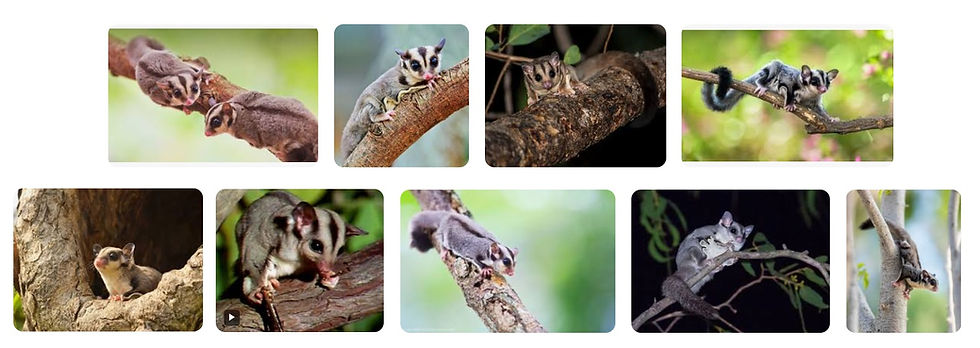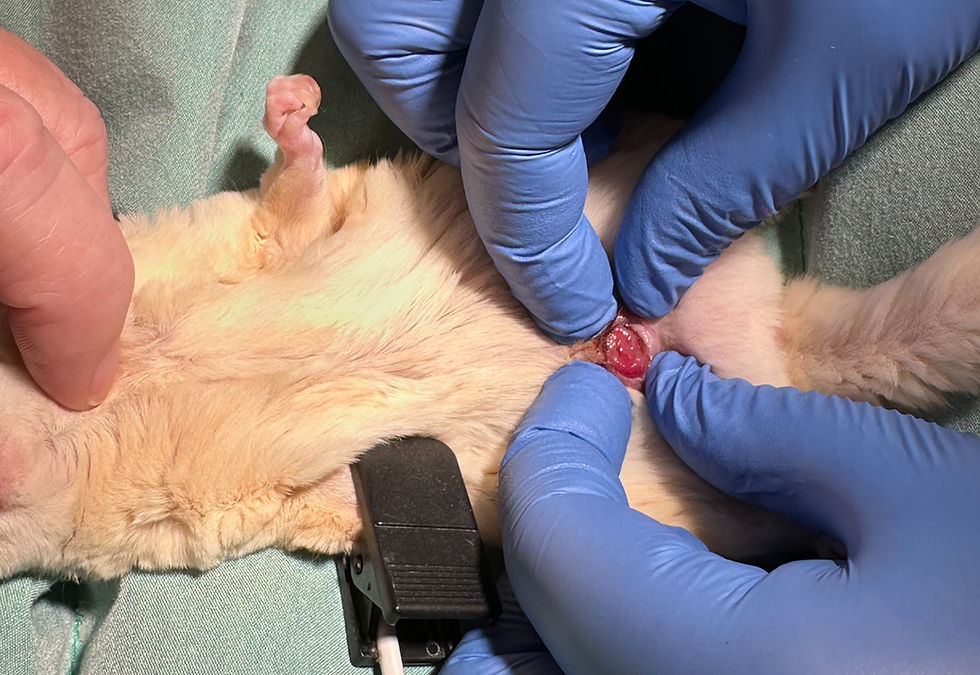Mammary Cancer in Sugar Gliders: What Every Owner Needs to Know
- Serena Caunce
- Mar 11
- 5 min read
Updated: Jul 31
Sugar gliders are undeniably cute and make fascinating pets.

However, like all animals, they are prone to certain health issues; one of the most concerning being mammary cancer. Recently, a client asked me why her sugar glider developed this type of cancer and why veterinarians aren’t educating clients about it. It’s a fair question, and the answer involves both veterinary care and responsible breeding practices.
Why Is Mammary Cancer in Sugar Gliders an Under-Recognized Problem?
Mammary cancer in sugar gliders is often considered rare, but in my professional experience, I have seen it in three intact, non-breeding female gliders in just the past two years. I suspect this is an under-diagnosed disease, with many gliders passing away without a necropsy to confirm the cause of death. (Edit: make that four intact females).


One of the reasons this cancer might be under-recognized is that many sugar glider owners do not bring their pets to the veterinarian regularly. Instead, they often rely on breeder advice or internet forums for medical guidance. While sugar glider owners are typically very dedicated, doing their own research and following every suggestion they find, this often leads to misinterpretation of symptoms and delayed treatment.
How Does Mammary Cancer Develop?
The pathophysiology of mammary cancer in sugar gliders is closely tied to their reproductive cycles. During each heat cycle, hormonal signals prepare the mammary glands for offspring. However, in non-breeding females, this process leads to continuous cell turnover. Every time the mammary cells divide, there is a risk of genetic mutations. Over time, these mutations can lead to the development of lumps and, eventually, aggressive cancer cells.

In many pets, spaying can reduce the risk of such cancers, but spaying female sugar gliders is not a practical option. Their reproductive anatomy is highly complex, featuring a bifurcated uterus and paired vaginas, making surgical intervention extremely challenging. As a result, intact females continue to cycle, perpetuating this cycle of cell turnover and increasing cancer risk.
Case Reports and Scientific Findings
Scientific literature provides valuable insights into the presentation and management of mammary cancer in sugar gliders:
Anaplastic Mammary Carcinoma: A case report by Keller, Siedenburg, and Burroughs (2014) described a sugar glider presenting with a rapidly growing mass near the mammary gland. The sugar glider underwent surgical removal of the tumor followed by radiation therapy. Unfortunately, complications arose after surgery, and the sugar glider was euthanized (Keller et al., 2014).
Metastatic Mammary Adenocarcinoma: A case report by Churgin, Lennox, & Huth (2015) detailed a sugar glider presenting with a mammary mass that was surgically removed. Histopathology confirmed metastatic mammary adenocarcinoma with metastasis to the lungs. Unfortunately, due to the progression of the disease, the sugar glider was humanely euthanized (Churgin et al., 2015).
Comprehensive Review of Sugar Glider Oncology: According to a review by Stans (2023), only a handful of neoplasia cases in sugar gliders have been reported, including mammary carcinoma and other tumour types. The prognosis for most cancer cases was poor, with limited long-term survival despite treatment. This review emphasizes the need for further research and awareness to improve early detection and treatment outcomes (Stans, 2023).
If you're a veterinarian and you're on VIN, you'll see several posts on cases of sugar glider cancers.
These case reports demonstrate the aggressive nature of mammary cancer in sugar gliders and the challenges of treatment, reinforcing the need for routine veterinary care and thorough diagnostics.
Recognizing the Signs of Mammary Cancer
One of the biggest challenges with mammary cancer is that it often presents subtly. Owners might notice:
Lumps around the mammary glands
Changes in eating habits
Unusual behaviour or reduced activity
Weight loss without obvious signs of illness
Excessive grooming of the pouch area
Changes in the coat colour around the pouch
Blood coming from the pouch
Sometimes, these signs are mistaken for a simple pouch infection, leading to home remedies and further delaying a proper diagnosis. If you notice any of these signs, it’s essential to consult a veterinarian as soon as possible.
For the Veterinarian
I handle sugar gliders while they are inside a pouch. They feel safer, crab less, and are more amenable to restraint while inside the cozy fleece of their pockets. I give either a subcutaneous or intra-muscular injection of a sedative for being able to evert or look inside the pouch and for taking fine needle aspirations.
If you are suspicious of a neoplasia, you can consider obtaining radiographs at the same time. Ensure you collimate to the thoracic cavity for a better view of the lungs.
How Is Mammary Cancer Treated?
The main treatment for mammary cancer in sugar gliders is surgery, specifically a radical mastectomy. However, before proceeding with surgery, it is crucial to determine whether the cancer has spread to other parts of the body. This involves imaging and possibly blood work to screen for metastasis.
If the cancer has spread, surgery is not recommended. Instead, the focus shifts to palliative care, which includes:
Pain management: Keeping the sugar glider comfortable and minimizing discomfort.
Monitoring quality of life: Watching for signs of pain, changes in eating, or difficulty breathing.
Humane euthanasia: If the glider is losing weight or struggling to breathe, euthanasia may be the most compassionate option to prevent suffering.
Breeding Practices and Genetic Risks
Another factor that may contribute to the development of cancers and other health issues in sugar gliders is inbreeding, particularly to achieve specific colour variations like cremino or leucistic gliders. Breeding for appearance can increase the risk of genetic diseases, a situation seen in other species as well.

For example, white-coated dogs like Boxers are more prone to congenital deafness, and the merle colour pattern in breeds such as Australian Shepherds is linked to ocular deficits. These examples highlight the dangers of prioritizing appearance over health, which can have serious consequences for pets.
Why Aren’t Veterinarians Educating Owners About This?
The reality is that most veterinarians would love to provide education on this topic. However, many sugar glider owners do not bring their pets in for routine care, often because they rely on advice from breeders or online communities instead. This makes it difficult for veterinarians to catch these issues early or even discuss them with owners.
The first point of education should ideally come from breeders and pet stores, who are often the first contact for new sugar glider owners. They play a crucial role in promoting the importance of regular veterinary check-ups and monitoring for signs of illness.
If you own a sugar glider, regular veterinary visits are essential to catch potential health issues early. If you notice any changes in your pet’s health, no matter how subtle, please consult your veterinarian. And if you are a breeder or work in a pet store, take the time to inform new owners about the importance of veterinary care. This small step could make a huge difference in the health and happiness of these wonderful little pets.
If you have questions or concerns about your sugar glider’s health, feel free to reach out!
For more information on the management of sugar glider mammary cancer, see the newest post here.









Comments